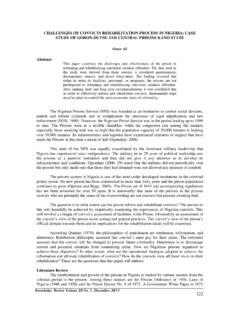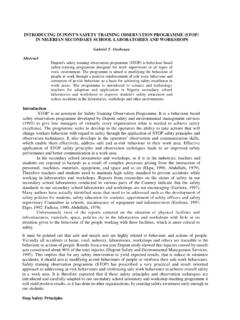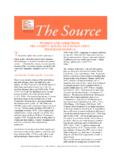Transcription of THE NIGERIAN PRISON SYSTEM AND THE FAILURE OF ...
1 1 THE NIGERIAN PRISON SYSTEM AND THE FAILURE OF rehabilitation : AN examination OF incarceration alternatives Moses U. Ikoh, ( ) Abstract Against the background of PRISON congestion and increase rate of recidivism in Nigeria, this paper examines the FAILURE of the NIGERIAN PRISON Service rehabilitative model. It discovered that the criminal label acquired by the offenders on conviction is reinforced by prisonization and inmates subculture. The inmates leave the prisons worse off on release, only to face a society whose members identify them only with that label. In want of what to do to eke out a living, crime often remains the only option, and they are recycled back to PRISON . The paper calls for alternative incarceration model as provided by reintegration. Such reintegration techniques as work-release programmes, parole, academic-pass programmes and the use of PRISON volunteers offer the advantage of keeping the convicts behind bars as well as allowing them to mix frequently with members of the society, whom they will meet on completion of their imprisonment term.
2 Introduction The NIGERIAN criminal justice SYSTEM stands on three legs: the police, the courts and the prisons. The effectiveness of the criminal justice SYSTEM is measured by its ability to meet the goals of deterrence, incapacitation, retribution, rehabilitation and reintegration. The realization of such goals depends on the level of coordination among the various agencies of law enforcement. At the early stage of a crime, if the police effects an arrest, the arrestee becomes a suspect . If eventually the suspect is arraigned in courts, his or her title changes to accused . The accused remains innocent until the court proofs otherwise. If the accused is not discharged and acquitted after trial and is sentenced, the title changes to a convict . The sentence may involve fines, probation (supervised release), or incarceration (confinement).
3 At this level, the PRISON takes him or her in as an inmate . Imprisonment thus becomes an act of legally restricting, limiting or confining a person. In Dambazau s (1999) assessment, imprisonment is one of the widely used criminal justice disposal methods in Nigeria. For the purpose of this paper, a PRISON is defined as any building declared by law where suspected or convicted criminals are legally kept with the intention to transform them into responsible and law abiding citizens. Imprisonment serves several universal functions, including the protection of the society, the prevention of crime, retribution (revenge) against criminals, and the rehabilitation of inmates. Additional goals of imprisonment may include the assurance of justice based on a philosophy of just deserts (getting what one deserves) and the reintegration of inmates into the community after serving their sentences (Conklin, 2001).
4 Locking up dangerous criminals or persistent non-violent offenders means that the society will be protected from them for the duration of their sentences. Thus, imprisoning criminals temporarily incapacitates them. Other than this, the expectation is that prisons will cause inmates to regret their criminal acts, and when they are released, will be deterred from committing further crimes (Alemika & Chukwuma, 2001). incarceration of criminals may also deter other individuals from engaging in criminal behaviour due to the fear of punishment (Pursley, 1977). Prisons are also called penitentiaries because of the belief that through solitary religious instruction while under confinement, prisoners would become penitent (remorseful) and reform their behaviour. Different countries place different emphasis on one or more of the enumerated incarceration goals.
5 In Nigeria, the constitutional amendment provision 366 of 1990 provides for the objectives of the NIGERIAN prisons thus: The NIGERIAN Academic Forum Volume 20 No. 1 April, 2011 2 (a) to keep safe custody of persons who are legally entered; (b) to identify the causes of their anti-social behaviour, treat and reform them to become disciplined and law abiding citizens of a free society; (c) to train them toward their eventual reformation, rehabilitation and re-integration to the society after their discharge; (d) to generate funds for the government through PRISON farms and industries (Jarma, 1999:196). It is a package of tangible and intangible provisions directed at inmates rehabilitation and reform so that they can pursue an independent and legally accepted way of life on discharge.
6 Based on this philosophy, the PRISON SYSTEM was equated with corrections. Imprisonment was therefore aimed at correcting criminals and transforming their behaviour, rather than merely penalizing them for their wrongdoing. It is debateable if that philosophy is achievable today, nor was it ever achieved in the past. Opinion differs, but several authors including Dambazau (1999), Jarma (1999), Alemika and Chukwuma (2001) and Otite and Albert (2004), argued that the PRISON SYSTEM in Nigeria is worse today than in the days after colonial rule. The workshops that were in the prisons have been converted into makeshift centers because of congestion. Where they still exist, there are no implements, no tools and incentives to put them to use. NIGERIAN prisons built for a gross capacity of 25,000 inmates are today overcrowded with over 417,000 inmates, and about 70 per cent of these inmates are Awaiting Trial Inmates (ATI).
7 This congestion is not without consequences. It has resulted in many related health problems of unsanitary environment, poor feeding, poor clothing, over stretched facilities, insufficiency, or even non-existence of welfare rehabilitation facilities. It also posses serious management problems as can be seen in the inability to separate hardened criminals from minor offenders (Odekunle, 1978). Cases of infections ranging from scabies, asthma, tuberculosis, rashes and HIV/AIDS have been recorded (Jarma, 1996). The year 2000 Country Report on Human Rights Practices in Nigeria remarked that the NIGERIAN Prisons conditions were harsh and life threatening (Otite and Albert, 2004). These conditions are by no means different today. The penal policy of reformation and rehabilitation in Nigeria is therefore a public disguise for modernizing imprisonment from the inherited colonial SYSTEM geared toward punishment, incapacitation and deprivation of incarcerated offenders (Alemika & Chukwuma, 2001: 11).
8 Judging from this background, this paper examines the FAILURE of the rehabilitation /reformative philosophy of the NIGERIAN PRISON . The paper argues that dysfunctional prisons do not only fail to deliver services, they silence the inmates through patterns of humiliation and exclusion. Since the inmates have no constructive ways of spending their time, they resort to filling the idle hours with reservoir of resentment, with the old criminals teaching the new ones new criminal tricks that they will take back to the society. The consequences are hardened criminals that come out of our prisons and the attendant high rate of recidivism. This informs the argument for alternative incarceration model. A Brief Background of Study In pre-colonial Nigeria, history has told us about the availability of prisons, where people who deviated from the societal norms and values were either kept for trial or punishment.
9 Among the Yorubas, there was a PRISON SYSTEM in Ogboni House. In the Tivland, a building was set aside in the chief s compound for offenders. There existed the Ewedo in the Bini Kingdom and the Gidan Yari among the Hausa-Fulanis. Individuals who sought redress from those who wronged them allowed the society to determine the type of punishment commensurate with the offence. Punishment was defended as permitting the offenders the feeling of having atoned for their actions while affirming among the law abiding members of society, the appropriateness of their noncriminal behaviour (Pursley, 1977). The advent of colonialism brought modern prisons to Nigeria. The PRISON SYSTEM Moses U. Ikoh, ( ) 3 became organized along the British PRISON model. In 1872, the Broad Street PRISON was opened in Lagos with a capacity of 300 inmates (Alemika & Chukwuma, 2001).
10 After the amalgamation of 1914, the Colonial Authority promulgated the 1916 ordinance which empowered the Director of prisons to make standing orders for organization, discipline, control and general administration of staff and inmates (Dambazau, 1999). Prisons were categorized into three types, viz., the maximum security prisons, the provincial prisons and the divisional or native authority prisons. The maximum security prisons were in Kirikiri, Enugu, Calabar and Orji River. They have high walls around them and convicts who had long sentences to serve were incarcerated there. The provincial prisons were located at Owerri, Ogoja, Makurdi and Onitsha to custody inmates whose sentences were not more than two years. The Divisional prisons were located at Nsukka, Uyo, Itu, Okitipupa, Umuahia and Kano, to take care of inmates whose sentences were less than two years.













